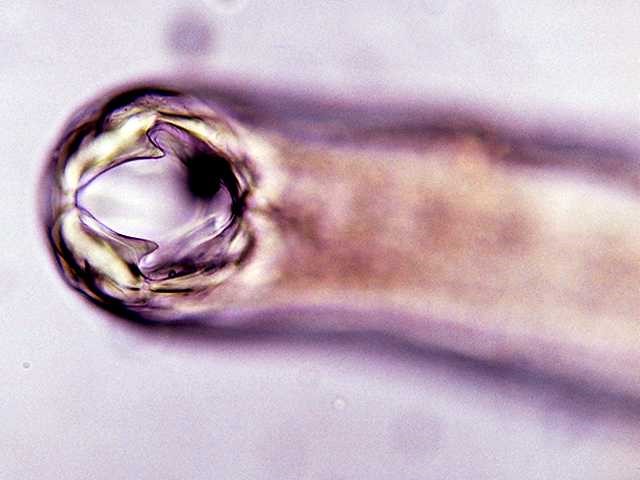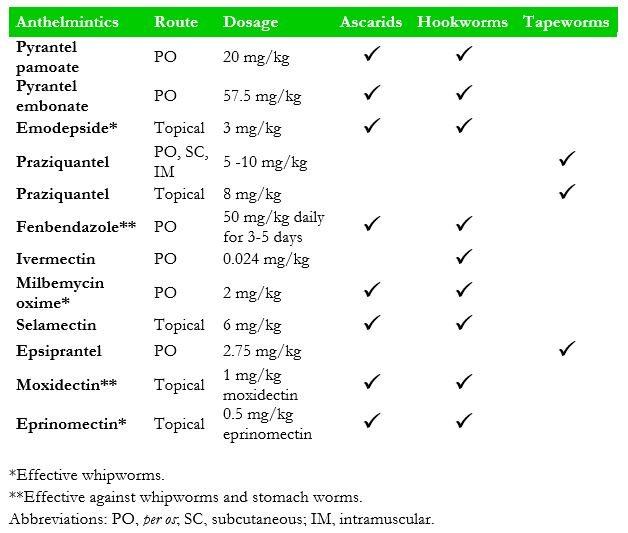Hookworms
(Ancylostoma spp., Uncinaria stenocephala)
Hookworms are nematodes that infect domestic and wild felids and cause severe disease in kittens. They are zoonotic (except U. stenocephala).
Distribution
Ancylostoma tubaeforme has a worldwide distribution. Ancylostoma ceylanicum is found in the wet tropics and subtropics of the Asia Pacific China, India and Africa. Ancylostoma braziliense is found in the wet tropics of Africa, Central and South America, Malaysia, Indonesia, and northern Australia. Uncinaria stenocephala is usually found in temperate, cooler climates in sub-tropical regions.
Clinical signs
Hookworm infection may be well tolerated in cats. In kittens, heavy infections may result in anaemia, diarrhoea, and weight loss. The cutaneous penetration of larvae may result in skin lesions (e.g. erythema, papules and pruritus). Respiratory signs and pneumonia may occur in kittens, in which infection may be fatal when large numbers of hookworms are present.
Diagnosis
Adult worms can be differentiated by morphology of the buccal capsule (Fig. 1, 2) and rays of the male bursa. Typical strongyle eggs can be recovered by standard faecal flotation (SOP 1). Eggs are oval, thin shelled, unembryonated when passed and approximately 52-79 μm by 28-58 μm in Ancylostoma spp. and 71-92 μm x 35-58 μm in U. stenocephala [1] (Fig. 2).
Treatment
For anthelmintic treatment options refer to Table 1.
Table 1 Routes of administration, dosage and efficacies of commonly utilised anthelminthics against the primary gastrointestinal parasites of cats [1,2].

Figure 1. Buccal capsule of Ancylostoma tubaeforme containing three pairs of teeth (Image credit: The University of Melbourne parasite image library)

Figure 2. Buccal capsule of Ancylostoma ceylanicum or Ancylostoma braziliense containing a single pair of teeth (Image credit: The University of Melbourne parasite image library)

Figure 3. Hookworm egg on faecal floation (Image credit: Dr. R. Traub)
Prevention and Control
Kittens should be treated against hookworms starting at 2 weeks of age and then every 2 weeks until they are at least 10 weeks old. Nursing queens should be treated simultaneously with their litters. Thereafter, cats should be treated monthly. Preventing predation and scavenging activities as well as prompt removal of faeces are also recommended.
For further control options, refer to the General Considerations and Recommendations section of these guidelines
Public health considerations
Hookworms are zoonotic agents and the most common cause of cutaneous larva migrans in humans. Ancylostoma braziliense causes prolonged cutaneous larva migrans or ‘creeping eruptions’ in humans. Ancylostoma ceylanicum is capable of producing patent infections in humans in regions where this hookworm is endemic in dogs and cats. Most common clinical signs in humans include abdominal pain, watery diarrhoea, melena and peripheral eosinophilia [3]. Uncinaria stenocephala is not considered zoonotic.
References
[1] Bowman DD, Hendrix CM, Lindsay DS, Barr SC. Feline Clinical Parasitology. Iowa State University Press, Ames, USA. 2002.
[2] Taton-Allen G, Cheney J. Gastrointestinal parasites. In: Lappin M (ed) Feline internal medicine secrets. Philadelphia, Hanley & Belfus, 2001; p. 85-95.
[3] Traub RJ. Ancylostoma ceylanicum – a re-emerging but neglected parasitic zoonosis. Int J Parasitol. 2013:43:1009-1015

